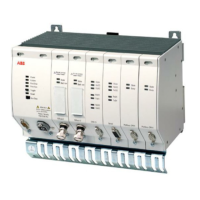4 Cabling the AC 800F
4-97
In the scenarios shown in the two illustrations above it is assumed that one A 800F is
connected to the end of the bus. If none of the two redundant AC 800F is connected
to the end of the bus cable, follow the instructions below:
• Deactivate the internal termination of the CAN modules.
• Deactivate the termination of the two terminal blocks TB 870F.
• Link the two redundant CAN modules FI 810F with the terminal block using cable
TK 831F. Only hand-tighten the screws.
• Put on the TK 831F cable shields. Connect them to the two AC 800F contact
ledges using clips TV 83xF.
• Connect the channels 0, 1 and 2 on the terminal blocks TB 870F to each other,
using the terminals specified below, and establish a connection to the I/O units.
Use twisted pair cable, e.g. 3 x 2 x 0.25 mm
2
or3x2x0.5mm
2
(total bus length
> 80 m) for connecting the terminal blocks to each other. Use the specified
standard cable for connecting the I/O units.
• Apply the shield to terminal P of the terminal block.
• Provide a termination at each end of the bus cable. Use CAN terminations DSU 01
for I/O units.
• When touching the terminating jumpers take the necessary ESD
protection measures. Follow the instructions given in Section 2.
• If the shield is not put on properly, neither RFI suppression nor
EMI/RFI shielding of the system can be guaranteed.
Fig. 4-77 shows two AC 800F with one CAN module FI 810F, each, cabled in a
redundancy link. The two AC 800F are not located at the bus cable ends.

